 |
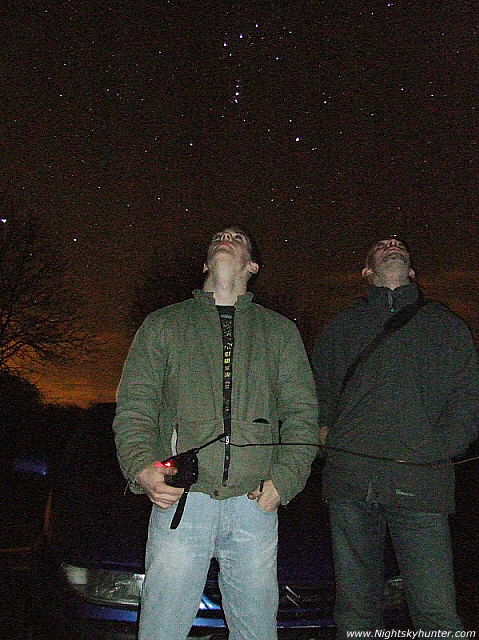 |
Conor Mc Donald (left) and Martin Mc Kenna observing at Drumlamph with Orion and Sirius above.
I was very much looking forward to the Leonid meteor shower this year after the success we had during the 2006 watch. The meteor forecast was not expected to be exceptional this year. On Sat/Sun night Nov 17th the usual nodal crossing would take place when the Earth passed through the trail of comet 55P/Tempel-Tuttle which would produce rates of 10-15 meteors per hour. This did not bother me as there was always the chance of the unexpected and you never know when a glorious fireball might suddenly drop into view. On the following night Sun/Mon Nov 18/19th experts were predicting two minor outbursts of faint meteors when the Earth fringed the 1932 dust tail from the comet. Dr. David Asher from Armagh Observatory predicted this outburst to occur after 23.00 UT when the zenithal hourly rate (ZHR) could exceed 60. However the radiant would be very low in the NE from N. Ireland at that time so smaller rates would be expected. There was only one way to find out and that was so to get outside and watch.
Of greatest concern was the weather. An active cold front was sweeping down over the Uk producing cloudy skies and long periods of rain. I was not discouraged as I knew from experience that the rear end of a front can produce fantastic clear skies. A northerly cold plunge was expected in the front's wake and when I checked the BBC online weather charts I was delighted to see that clear skies and a frost was on the cards. Things were looking good!. On Saturday night at 23.15 UT the first clear patches began to appear in the clouds. While standing at the backdoor I could see comet 17P/ Holmes with the naked eye beside Alpha Persei. This gap was only 5 minutes in duration but I made the most of it by getting three images of the comet and a good view through 10x50 binos and the 8.5" F/7 reflector which was set up swiftly in the back garden.
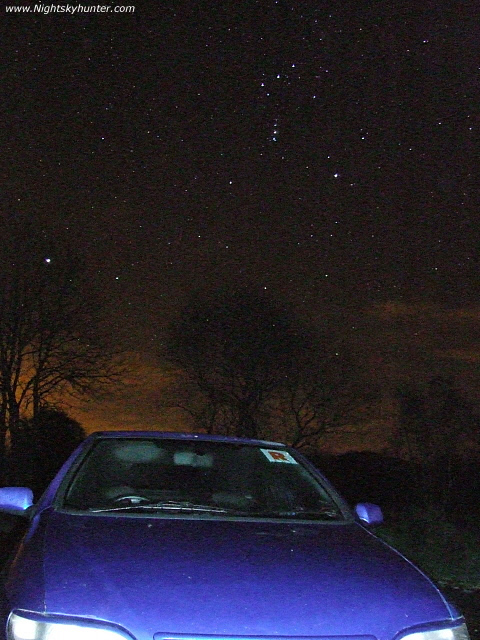 |
The red glow of M42 can be seen in Orion's sword. Facing SE with Conor's car in foreground.
At 23.50 UT the sky finally began to improve very slowly from the west and within 30 minutes the entire sky was clear. At this time I was watching the sky while talking with John Mc Connell over the phone who was checking his own sky from Maghaberry, N. Ireland. The clear breaks where arriving at his location also. We discussed the comet and meteor prospects. I was also keeping an eye on the low western sky as lightning was being detected over the western coast of Ireland and radar was picking up heavy rainfall echoes from large cells. They where not expected to come this way at all but I was keeping an eye out for lightning reflections in the sky. At this time I observed my first 2 Leonid meteors of the night burning up low in the west within the circlet of Pisces. Each meteor was of the 3rd mag and sported beautiful long blue/green tails. John ended the call to take advantage of the clear sky and image comet Holmes.
At this time Conor Mc Donald arrived in the back garden and I knew from his arrival that this was going to be a good session. First priority was to show Conor the comet in the scope, then he seen it himself very easily with the naked eye above the house rooftop. Conor showed me some impressive video footage he recently captured of large waves crashing on the volcanic shoreline along the Causeway coast during a stormy day. We decided to make a plan and watch this meteor shower. Within 15 minutes our gear was packed and we were on our way.
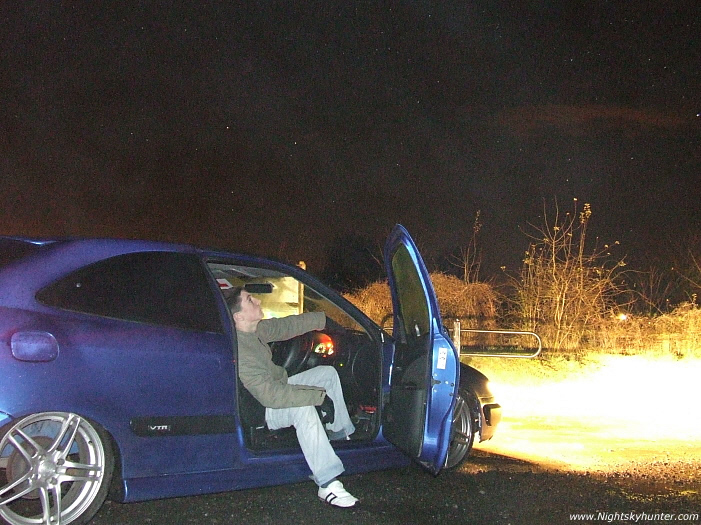 |
Conor warming up before another cold session. Facing west.
We drove to Drumlamph forest outside Maghera and decided to observe from the small car park. The night was crystal clear and silent. We could hear the rushing of a loud stream which was now active from heavy rain falling over the mountains over the last few days. The sky was quite stunning, very dark, transparency 8/10 and VERY cold but at least it was calm with no wind chill. A few glowing cumulus clouds hung around in the south but there was no threat from these. As soon as we were dark adapted we leaned back against the car and enjoyed the view. The CD player in the car was playing a wide range of Christmas songs (yes, I'm serious) which really added to the atmosphere. This location was extremely dark and surrounded by dark trees which added to its beauty. Above one of these trees Orion and Sirius where shinning brightly in a crisp dark sky. The Dipper was standing on end in the north between a natural gap in two lines of tall trees. Between Aries and the head of Cetus we could see the soft oval glow of the Gegenschein and running away from this to the east was the Zodiacal band which met the Winter Milky Way in Gemini. West of the zenith was comet Holmes almost touching Mirphak. I took a quick image of the comet.
We began to see meteors and kept an accurate count. This year we would be counting Leonids only however others could be seen from Taurus along with the sporadic background rate. We seen quite a few Leonids and every single one of them left a long glowing green straight ion train in their wake for a second or two. Several border-line fireballs dropped into the west and one beauty in the SE in Lepus. I did a short patrol with the camera at ISO1600, 15 second exposure at F/3.2. After some time I put the camera away to concentrate on visual observing as I was concerned that the cold would effect the life of my batteries. During quiet spells of activity we had a great chat about photography, past observing sessions and our storm chasing exploits during the Summer.
It was well into the early hours of the morning and the temperature had dropped fast. We were absolutely freezing and decided to warm up inside the car where we continued watching. Even through the car windscreen the stars were bright and glorious. Conor let a yell out of him when he seen a mag -3 to -4 brilliant white and orange Leonid fireball cross the sky which I missed. He was still excited, switched off the CD player and got out of the car into the still night. I looked up and could actually see the long green ion train sitting in the sky above the Beehive cluster for what must have been 10 seconds. This was the highlight of the night.
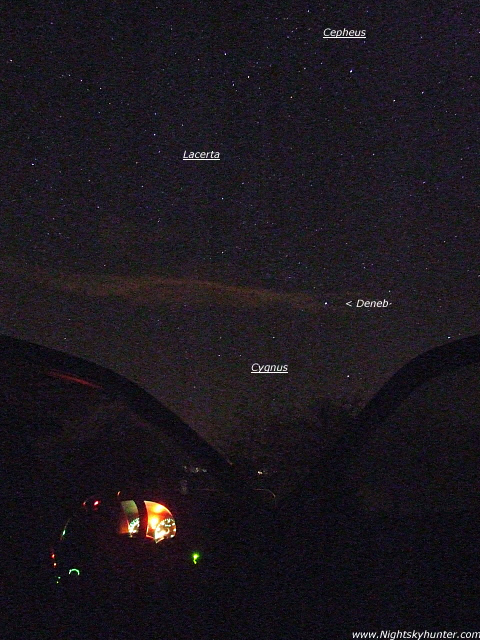 |
Constellation view in west. Conor's lit dash and open door in foreground.
By 02.30 UT we decided to head home and through the car windscreen we continued to monitor the sky as we drove along the dark and lonely Coleraine Road. Conor dropped me off and headed for home. I continued watching from the back garden. I also continued my meteor patrol until the battery went dead on my camera so the rest of the session was a visual one only. I had a great look at comet Holmes through the telescope and did a search for 8P/ Tuttle however the sky was hazy around the Pole. Before dawn I searched for new comets low in the NE sky within Bootes however the haze was causing problems. I did catch one meteor tonight on camera before the battery failed. In the NE a mag + 2.0 orange coloured Leonid shot down through Corona Borealis very close to the faded variable RCrB. It was so low that the meteor's head was below the rooftop of my neighbour's house however the tail was extending above and this was what I caught on the patrol image. Not spectacular by any means but a result anyway!.
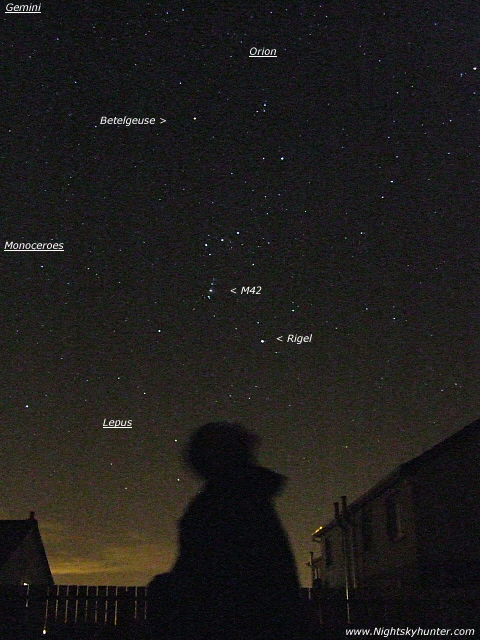 |
Back at home with the Winter stars aloft.
Just before dawn I watched the sky slowly brighten in the east with Virgo well up and Venus begging for attention north of Spica. I even thought I could glimpse the elusive Zodiacal light pyramid but I would need a better night to confirm. I stood and watched the twilight advance and spotted the first satellites emerging from the Earth's shadow. It was so peaceful and silent. The only sound I heard was the brief call from some distant fox then all was quite again. The meteor activity remained very low and unimpressive which was quite shocking so I ended the session at 06.30 UT after logging 44 Leonids. The action was minimal but it was still a wonderful and successful night and there was always the outburst on Sunday night. Before I went to sleep at 07.00 UT I glanced out of my window. I saw a spectacular sight. Along the NE - E horizon I could see a line of giant cumulus congestus clouds as completely black sharp forms against the dark blue morning twilight. They where enormous and looked like mountains!. They slowly bubbled up and one formed a small anvil. I wished my camera was still charged to get a shot of that scene showing monster convective clouds and stars above!. Sleeping was calling so I retired for the night.
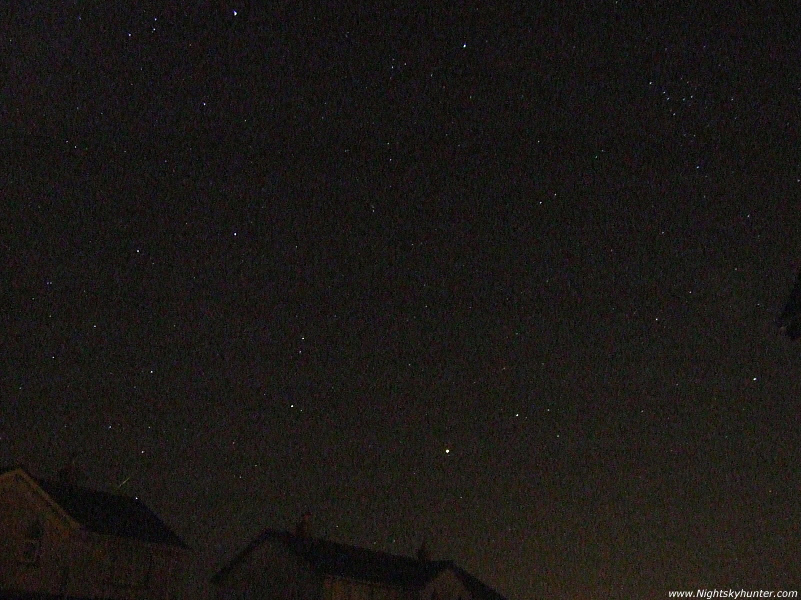 |
The tail of a mag +2.0 Leonid meteor can be seen to the far left above the rooftop. Arcturus is the bright star at centre.
Unfortunately the weather front produced a day and night of clouds and showers so I missed the outburst when the radiant rose after 23.00 UT. I did glimpse a few stars in the west and comet Holmes over Alpha Persei for a few seconds but that was it. As it turns out, I heard that on the previous night most observers were completely clouded out which was a shock considering it was crystal clear here all night long, so Conor and I were very fortunate to see what he did!. We had a good session which will be a fond memory to look back on. What's next on the meteor front?. My favourite shower of all - the 'Geminids' will peak in mid December followed by the minor 'Ursids' before Christmas which are prone to outbursts. After these the 2008 season begins with the Quadrantids so I hope to get good results from these showers. Make sure to check back for updates
Clear skies
Martin Mc Kenna